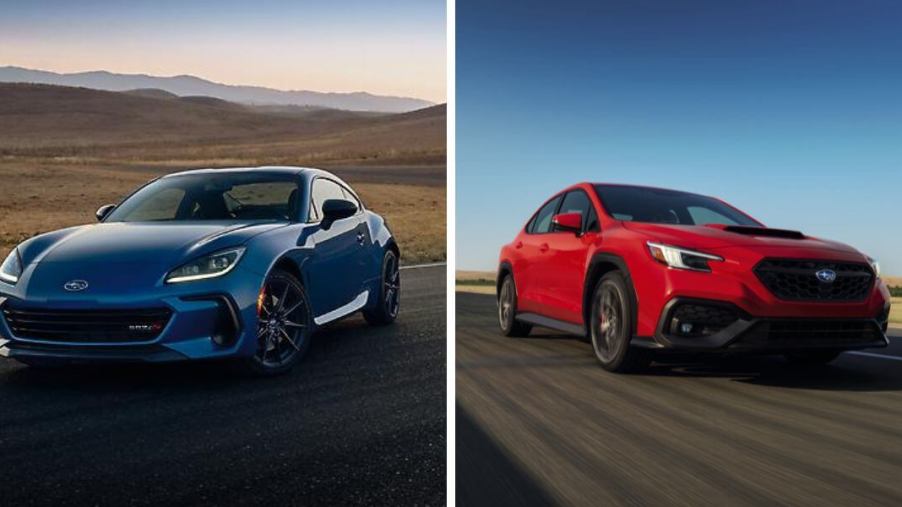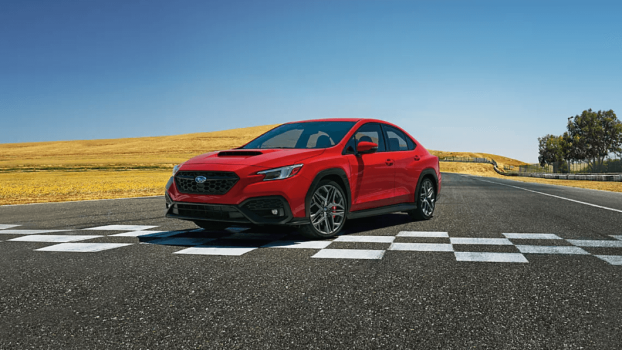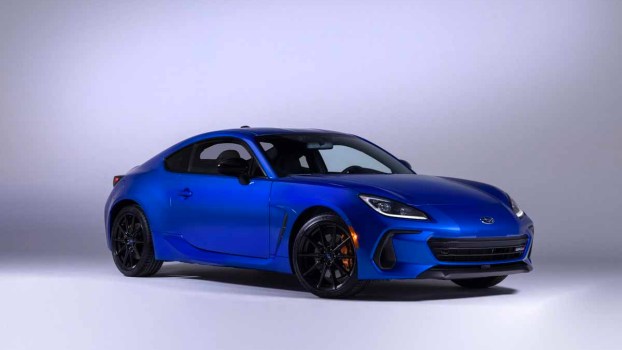
Why Does Subaru Sell Both the BRZ and WRX?
From the outside, the Subaru BRZ and WRX seem almost identical. Both are performance-focused models with similar pricing and looks. So, why does Subaru sell both models?
However, the BRZ and WRX are quite different. From their powertrains to their functionality, the two Subarus follow a different path. Each suits a specific type of driver, from pure performance enthusiasts to those who need everyday versatility. Let’s take a closer look at Subaru’s two performance cars, how they’re similar, and how they’re different.
Who is the Subaru BRZ for?
The Subaru BRZ follows the classic sports car formula: lightweight, rear-wheel drive, manual transmission (auto optional), and a high-revving powerplant. Together, those elements aim for one thing: driving thrills. Add a sleek exterior design and reasonable pricing, and you’ve got an ideal ride for the enthusiast on a budget.
The BRZ starts at $28,595, according to Edmunds. That’s a striking deal for a spunky sports car. Typically, performance-focused sports cars cost tens of thousands more, so this two-seat RWD performer lets more people get behind the wheel.
A Subaru flat-four boxer engine resides under the hood. Displacing 2.4 liters and producing 228 hp and 184 lb-ft of torque, the racy powerplant rockets the BRZ to 60 mph in 5.4 seconds, as tested by Car and Driver. Of course, it also has that classic boxer growl.
Key to the BRZ’s performance is its lightweight build. At around 2,800 lbs, the two-seater displays agile, balanced performance in all conditions. Additionally, its compact dimensions give it the taut appearance reserved for real sports cars.
The BRZ suits driving enthusiasts who want the classic sports car experience. The BRZ doesn’t compromise between dynamics and utility: it’s built to carve corners and hit the track. That means no rear seating and limited trunk space. And RWD isn’t best suited for snowy weather, making it an outlier among its Subaru family that offers standard AWD on all other models.
However, when the revs climb and the G-forces build, the Subaru BRZ is in its element.
Who is the Subaru WRX for?
The Subaru WRX (from $30,605) is also a performance car but with extra horses and everyday utility. All-wheel drive adds all-weather traction and four doors means you can bring along your friends.
The heart of the WRX is its turbo 2.4-liter boxer engine. Producing 271 hp and 258 lb-ft of torque, it offers rally car muscle and sweet turbine sounds. That’s routed through a six-speed manual or a smooth CVT and Subaru’s Symmetrical All-Wheel Drive. It’s fast, too. MotorTrend obtained a 0-60 mph time of 6.0 seconds.
With its 4-door sedan body style, the WRX is a sports car you can live with. Whether on a grocery run or a weekend trip, the ‘Rex has ample trunk space and seating for five.
Subaru’s rally car for the street also looks good, with pronounced fenders and a hood vent. It’s aggressive without being overdone for a just-right level of performance flair. You can take it to the movies or the track, and it looks at home.
While sports car fans thirst for horsepower and spirited driving, not everyone can own a focused driving machine. Many people need a versatile vehicle with cargo space and all-weather capability. Still, having a turbo engine, AWD, and a tuned chassis is also lovely. For them, the WRX strikes the perfect balance.
The Subaru BRZ also has an (almost) identical twin
The Subaru BRZ came about through a partnership with Toyota, which produced its own sports car version called the 86 (now the GR86). While the cars are pretty similar, subtle differences give each its unique personality.
Road & Track spells out the distinctions between the BRZ and GR86. Style-wise, the Toyota displays a streamlined fascia with a large mesh grille, angled headlights, and L-shaped intakes. The Subaru has a lengthened nose, additional creasing, and a narrower grille. Though the variations are minor, they create distinct appearances.
Both cars share an identical engine, but according to Subaru, each company performed its own tuning. However, during testing, R&T didn’t note much of a difference.
However, it’s the chassis setup that really sets the two apart.
To start, the BRZ and GR86 have different damper settings. Additionally, the Toyota’s front spring rate is 7% lower, while its rear spring rate is 11% higher. And the Subaru uses an 18.3-millimeter front sway bar that’s slightly thicker than its counterpart’s.
Additional contrasts include stiffer rear trailing bushings and aluminum front suspension knuckles on the Subaru, compared to the Toyota’s carry-over bushings and steel knuckles.
According to Subaru, the automaker designed the BRZ for “stability and precision.” Road & Track found that a worthy description. The outlet noted the Subaru’s precise turn-in and tendency to push during at-the-limit cornering while finding the Toyota slightly more likely to oversteer.





